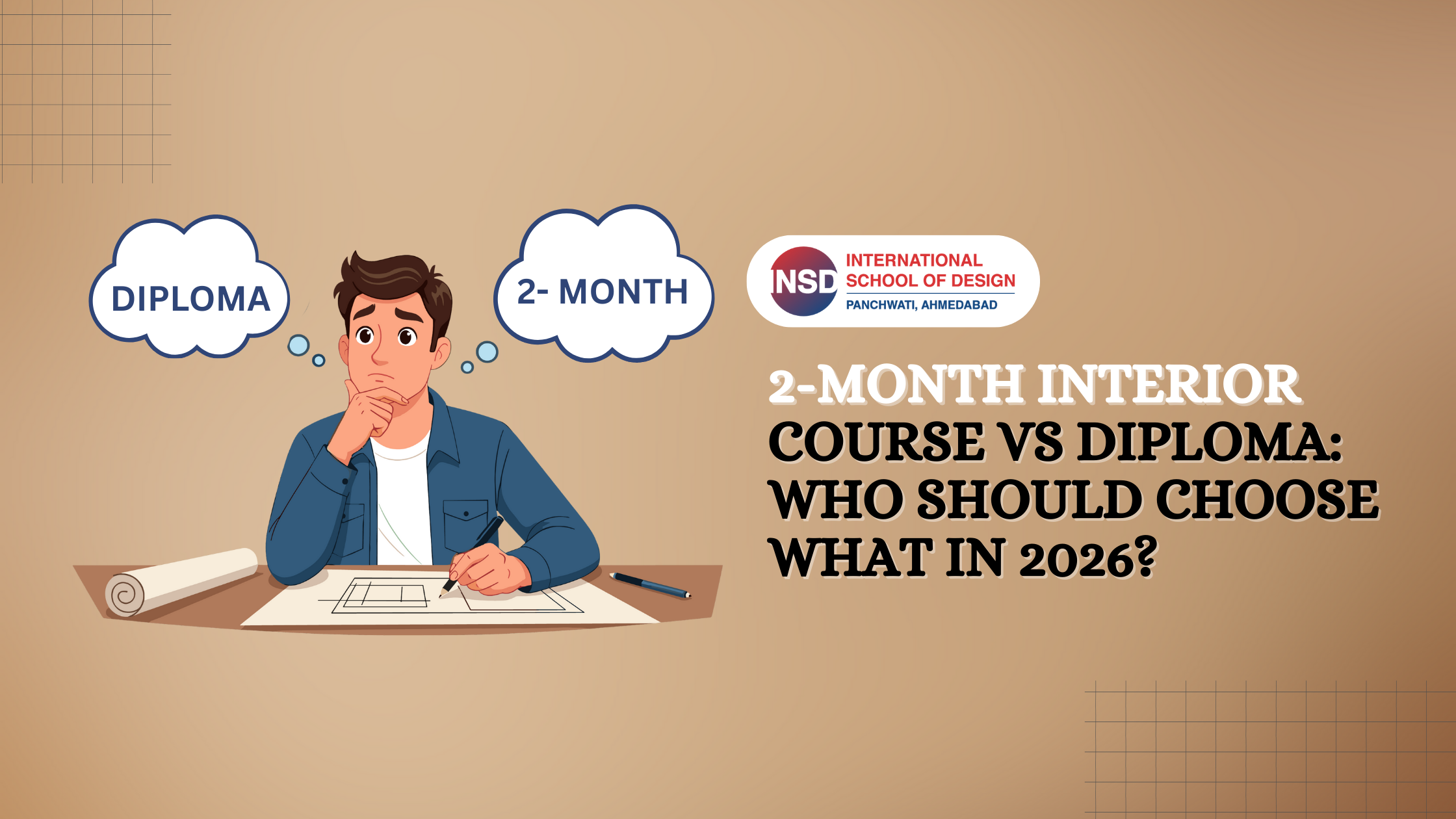If you’re interested in interior design and planning your next steps for 2026, you’ve probably come across two main options: short-term courses and diplomas. Both can shape your career, but they serve very different purposes. Understanding which one fits your goals, timeline, and learning style is essential before you make a decision.
Let’s break down the differences, benefits, and ideal candidates for each path so you can make an informed choice.
What Is a 2-Month Interior Design Course?
A 2-month interior design course is a short, skill-focused program designed for students or enthusiasts who want to explore the basics of the field quickly. These courses are usually practical, hands-on, and flexible, allowing you to:
- Learn fundamental design principles
- Understand space planning and layout basics
- Work with materials, textures, and colours
- Create mini-projects and mood boards
The main advantage is speed, you get exposure to interior design in just a few weeks, making it perfect for students who are still exploring career options or professionals looking to upskill.
What Is an Interior Design Diploma?
An interior design diploma is a longer, more comprehensive program, often spanning 6–12 months. It covers both fundamentals and advanced topics, such as:
- Detailed CAD drawings and 3D modelling
- Advanced space planning
- Project management and client communication
- Interior styling and decoration for residential and commercial spaces
- Industry practices and design business insights
Diplomas are ideal for students who are serious about pursuing interior design professionally and want a deeper understanding of the field.
Who Should Choose a 2-Month Course?
Short-term interior courses are best suited for:
- Students exploring careers
If you’re unsure whether interior design is right for you, a 2-month course gives hands-on exposure before committing to a diploma or degree. - Working professionals
If you want to add design knowledge to your current skill set without taking a long break, short courses are flexible enough to fit your schedule. - Portfolio building
Even short-term courses let you create mini projects, mood boards, or digital designs that can enhance your portfolio for future admissions. - Quick skill upgrades
Want to learn basic CAD or interior styling techniques for freelance work or side projects? Short courses offer targeted learning without long-term commitment.
Who Should Opt for a Diploma?
Diplomas are suited for those who are committed to a career in interior design:
- Students planning 2026 admissions
If you’re aiming for a degree or professional pathway, a diploma provides deeper knowledge and stronger credentials. - Those seeking in-depth technical skills
From 3D visualization to project management, diplomas cover all the tools and techniques needed for professional practice. - Career-ready learners
Diplomas prepare you for client interactions, real projects, and industry standards, which is essential if you want to start working immediately after the course. - Portfolio-focused students
With multiple projects and practical assignments, diplomas give you a comprehensive portfolio that can impress design colleges and employers alike.
How to Decide Between a 2-Month Course and a Diploma
Choosing depends on your goals, timeline, and level of commitment:
- If you’re exploring, testing interest, or want quick exposure → go for a 2-month course
- If you want professional readiness, in-depth skills, and a complete portfolio → choose a diploma
Think about your career path, availability, and learning style. Short courses are fast and practical; diplomas are detailed and career-oriented.
Can You Start with a Short Course and Later Do a Diploma?
Yes, absolutely. Many students start with a short-term program to gain clarity and then transition to a diploma once they’re confident. This approach offers the best of both worlds:
- Early exposure without long-term commitment
- Time to explore different design styles and tools
- Better focus and preparation for diploma projects
It’s a smart way to make a decision for 2026 admissions.
The Role of AI and Digital Tools in Modern Interior Courses
Even short-term courses now integrate AI powered tools, design software, and visualization apps:
- Generate 3D models and layouts quickly
- Experiment with colours, textures, and lighting virtually
- Use AI assistants or chatbots for instant design guidance
These tools make learning interactive, modern, and aligned with industry standards, whether you choose a 2-month course or a full diploma.
Benefits of Choosing the Right Program for You
Short-Term Courses
- Fast skill acquisition
- Low commitment
- Flexible schedules
- Early portfolio work
Diplomas
- Comprehensive understanding
- Professional skill set
- Strong portfolio for colleges or jobs
- Better career readiness
Both paths have their value; the key is matching the course to your needs and goals.
How INSD Ahmedabad Supports Both Options
At INSD Ahmedabad, students can choose short-term interior courses or diploma programs, depending on their goals. Both are designed to be hands-on, industry relevant, and flexible, with online and offline options to fit your schedule.
- 2-Month Courses: Ideal for students exploring interior design or building quick skills for portfolios.
- Diploma Programs: Perfect for committed learners seeking in-depth technical knowledge, professional readiness, and a strong portfolio for 2026 admissions.
With experienced faculty, AI-powered tools, and practical projects, INSD helps you gain clarity, confidence, and real-world experience, no matter which path you choose.
Final Takeaway
Whether you start with a 2-month interior design course or dive into a Interior Design Diploma, the important thing is exploring your interests and building skills early. Short courses give fast exposure, while diplomas prepare you for a professional career. Many students even combine both: test the waters first, then commit to a diploma with confidence.
If you’re aiming for 2026 admissions and want a flexible, practical, and supportive learning environment, INSD Ahmedabad provides the tools, mentorship, and experience to guide your interior design journey.


